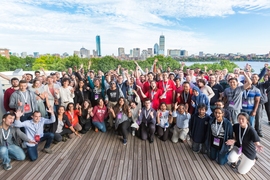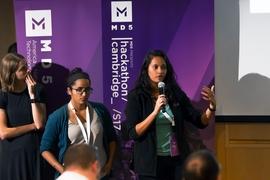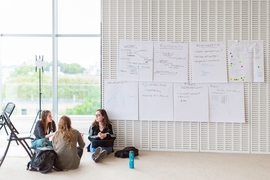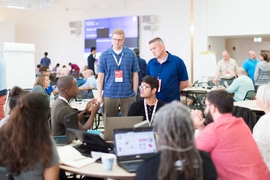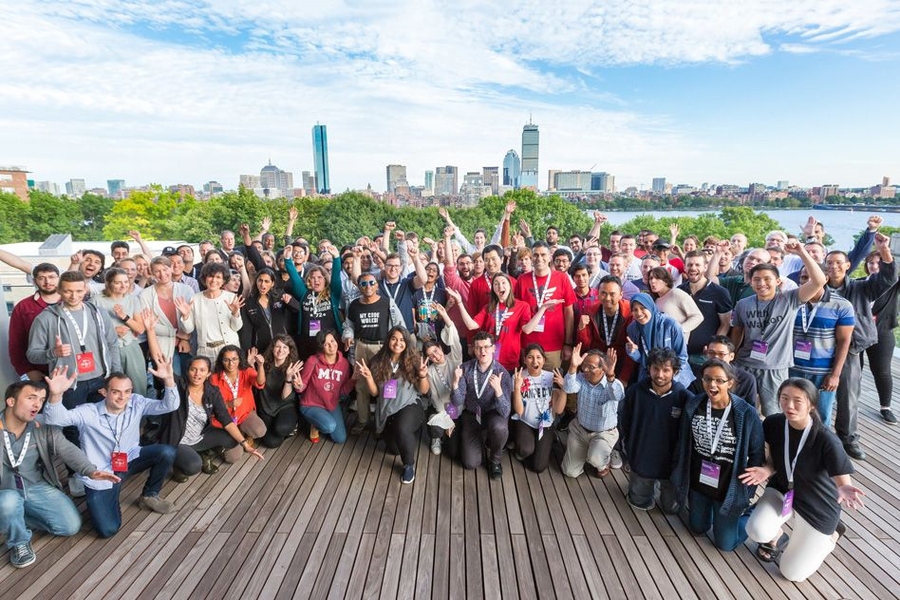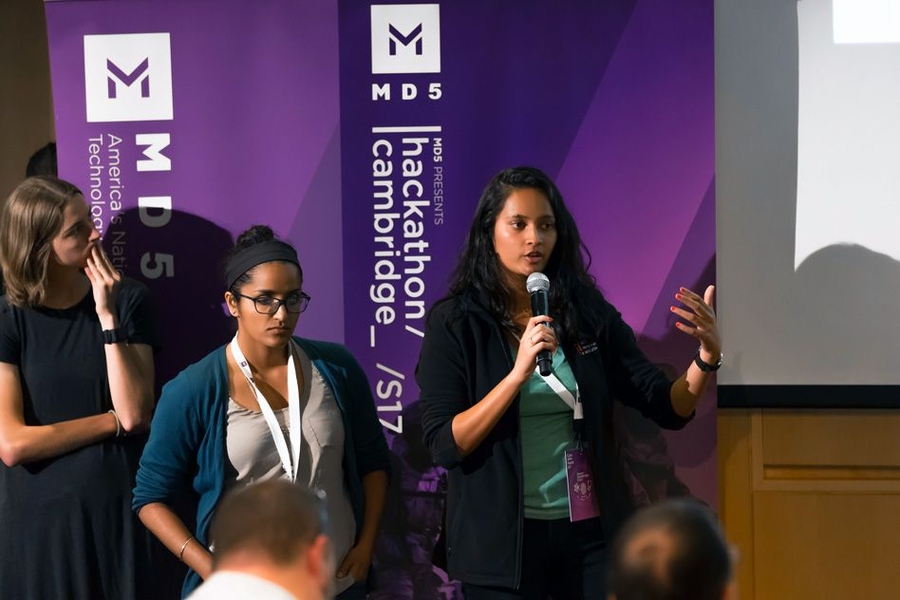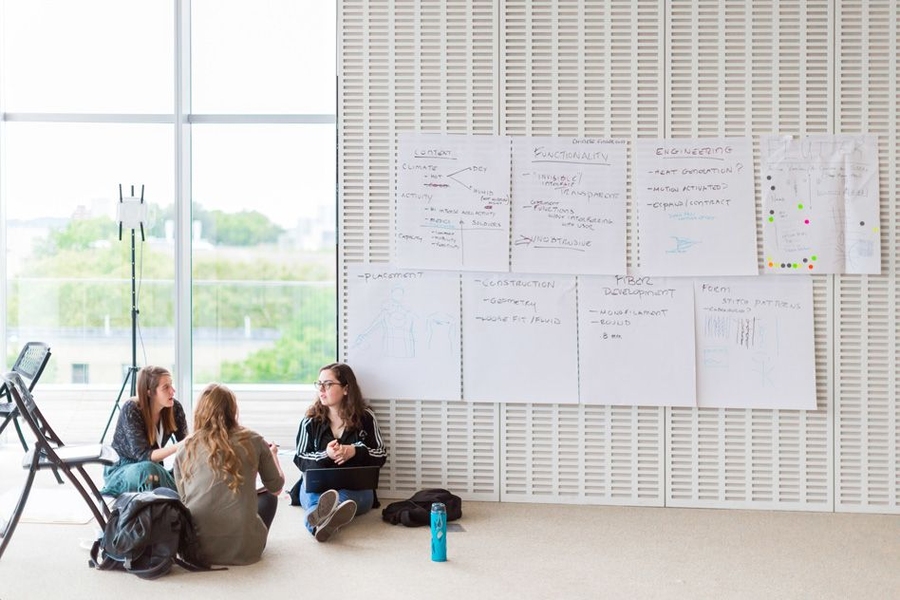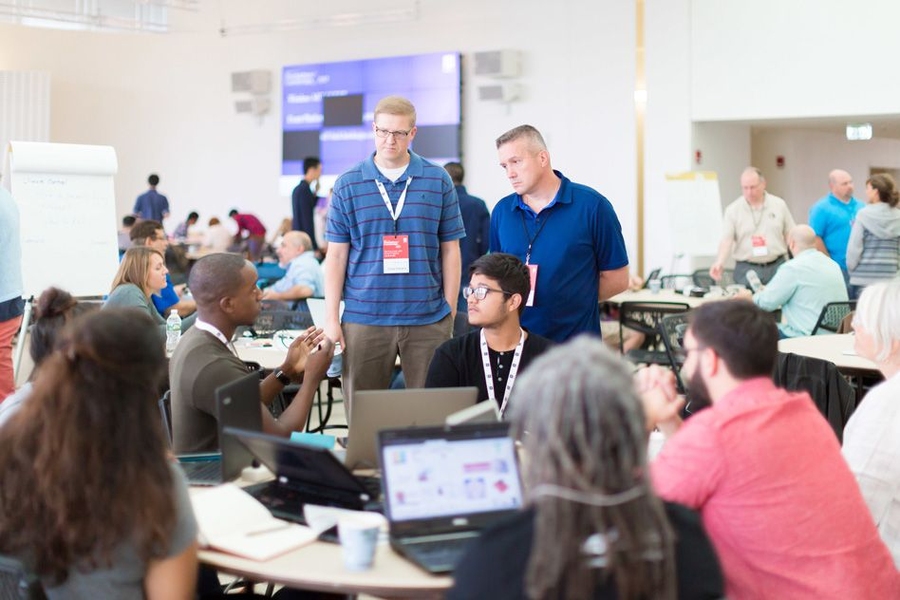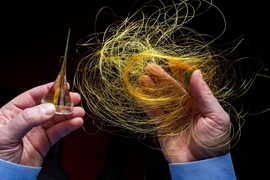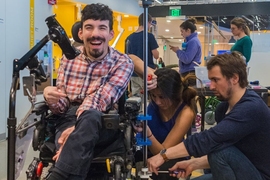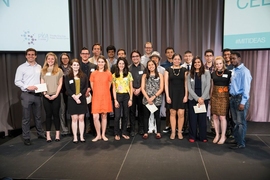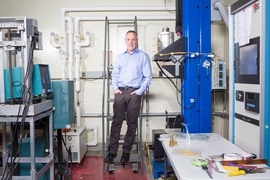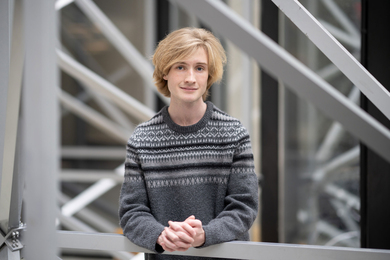Hazardous environments such as disaster sites and conflict zones present many challenges for emergency response. But the new field of functional fabrics — materials modified to incorporate various sensors, connect to the internet, or serve multiple purposes, among other things — holds promise for novel solutions.
Over the weekend, MIT became a hotbed for developing those solutions.
A three-day hackathon on campus brought together students and researchers from MIT and around Boston who developed functional fabric concepts to solve major issues facing soldiers in combat or training, first responders, victims and workers in refugee camps, and many others. The event was hosted by the MIT Innovation Initiative, the Advanced Functional Fabrics of America (AFFOA) Institute, and MD5, a partnership between the U.S. Department of Defense (DoD) and a network of national research universities.
Participants pitched their ideas on Friday night. By Sunday afternoon, more than 20 teams stationed around the MIT Media Lab’s sixth floor had design mockups drawn on poster boards, algorithms and brainstorming notes scribbled on large sheets of hanging paper, and even hardware and software prototypes on display.
Two winning teams earned grand prizes of up to $15,000, courtesy of MD5. Remote Triage, formed by MIT students, designed an automated triage system for field medics, consisting of sensor-laden clothing that detects potential injury and a web platform that prioritizes care. The other team, Security Blanket, designed a double-sided, multipurpose blanket for people displaced from their homes, based on an idea from a Drexel University student.
Some other ideas included smart belts that passively detect radiation exposure in submarines; military gear fitted with radio-frequency identification tags to manage materials and improve packing efficiency; biometric-monitoring stickers that detect potential post-traumatic stress disorder symptoms; lightweight body armor designed to better protect the heart and neck; stress-detecting shirts that improve military training exercises; and uniforms made with materials and tiny fans that deliver cool and hot airflow across the body. All teams were invited to continue working with MD5.
“This is just the start,” Bill Kernick, technology and partnership development executive for MD5 told MIT News. “The idea of the hackathon is getting the sparks of these ideas moving and creating a relationship with these innovators, who may have not thought about working with DoD, to help solve some really hard problems.”
In that regard, Vladimir Bulović, co-director of the MIT Innovation Initiative and the Fariborz Maseeh (1990) Professor of Emerging Technology, said the hackathon embodies MIT’s goal of developing innovations for real-world applications. “As long as we can deliver impact that leads toward productive next steps, we have succeeded in our mission,” he said.
Through the hackathon, Bulović added, participants were also introduced to the newly launched AFFOA — a consortium of which MIT is a partner — and learned about the ever-growing possibilities of functional fabrics. “Fiber as a format that can deliver electronics, optics, photonics … is an entirely new platform that has not existed before,” he said. “It’s a new frontier.”
On Friday night, hackathon participants listened to talks from various experts — including military officers, first responders, and government representatives — who described major challenges they face in their fields. Participants brainstormed solutions, pitched their ideas to all attendees, and ultimately formed a total of 22 teams. Experts and mentors, from MIT and elsewhere, were on hand all weekend to help teams shape their ideas. (Some experts also joined individual teams.) On Sunday, a panel of judges — including representatives from industry, AFFOA, and MIT — chose 10 teams as finalists to pitch ideas, with two teams emerging as the big winners.
Some teams entered the hackathon with established ideas they wanted to refine. The finalist team OREverywhere, for instance, tweaked its augmented-reality (AR) headgear over the weekend to help field medics. The AR system displays biometric information collected from wearable sensors worn by soldiers and connects all medics on the field. A medic, for instance, can see when a soldier is injured, alert nearby medics, provide advice during care, and monitor everything via video feed — all while helping another soldier. During Sunday’s pitch round, the team presented a live demonstration.
Other teams developed their concepts entirely over the weekend. The MIT students of Remote Triage, who are all friends, landed on their winning idea during dinner, after hearing from an expert about problems with battlefield triage efficiency. “We came in with literally nothing. We weren’t even planning on pitching,” team member Aditi Gupta, a PhD student in the Harvard-MIT Program in Health Sciences and Technology, told MIT News.
In two days, the team of six, including a former military officer, designed a mockup of an automated triage system called VITAL. It includes a garment integrated with sensors that continuously monitor vital signs. Signals are sent to a machine-learning algorithm that determines the necessary order of care for injured soldiers, from least urgent to most urgent, color-coded as green, yellow, red, and black. Other features also help the medic determine the whereabouts of the soldier down and the location of their injury, among other things.
With the prize money and other resources from MD5, Gupta said the team now aims to design sensor-laden clothing and further develop the machine-learning algorithm that will power their platform. They’re meeting with MD5 next week to discuss options for moving forward.
Gupta was surprised at how much the team completed in a short time. Hackathons, she added, really help participants — especially tech-minded MIT students — find real-world applications for their ideas and people to help make those ideas a reality. “Hackathons are useful in opening your mind and seeing the bigger picture in terms of how your technology fits in society,” she says, “as well as meeting people out of your field that have knowledge and expertise you don’t.”
Christina Kara, a Drexel University student who manages a lab that researches functional fabrics, had a similar experience. After hearing a first responder talk about working with Hurricane Katrina victims — who were in desperate need of tarps and blankets, and suffered from bacterial skin infections — she pitched the winning concept behind Security Blanket.
Teaming up with that first responder and a few others, the group developed a multipurpose comfort blanket for refugee camps or disaster relief that consists of a waterproof, flexible, robust material on the outside. The inside is lined with antimicrobial, soft, and quick-drying microfibers. The blankets can roll out into a sleeping bag or fold into a backpack. Luminescent strips on the outside improve safety by increasing visibility at night, as well.
“In the five minutes we’ve talked to you, 100 people have been displaced in the world,” Kara said during her team’s pitch. “This is not a problem that’s going away. When we have something that’s fairly affordable, multiuse tool to empower them in their everyday life … you’re improving the experience of these individuals.”
After being announced a winner on Sunday, Kara was in shock, but excited to move forward with her idea, with help from MD5. “Being in a situation, where I have a problem to solve and think about was a new experience for me,” Kara told MIT News. “It was an amazing experience.”
